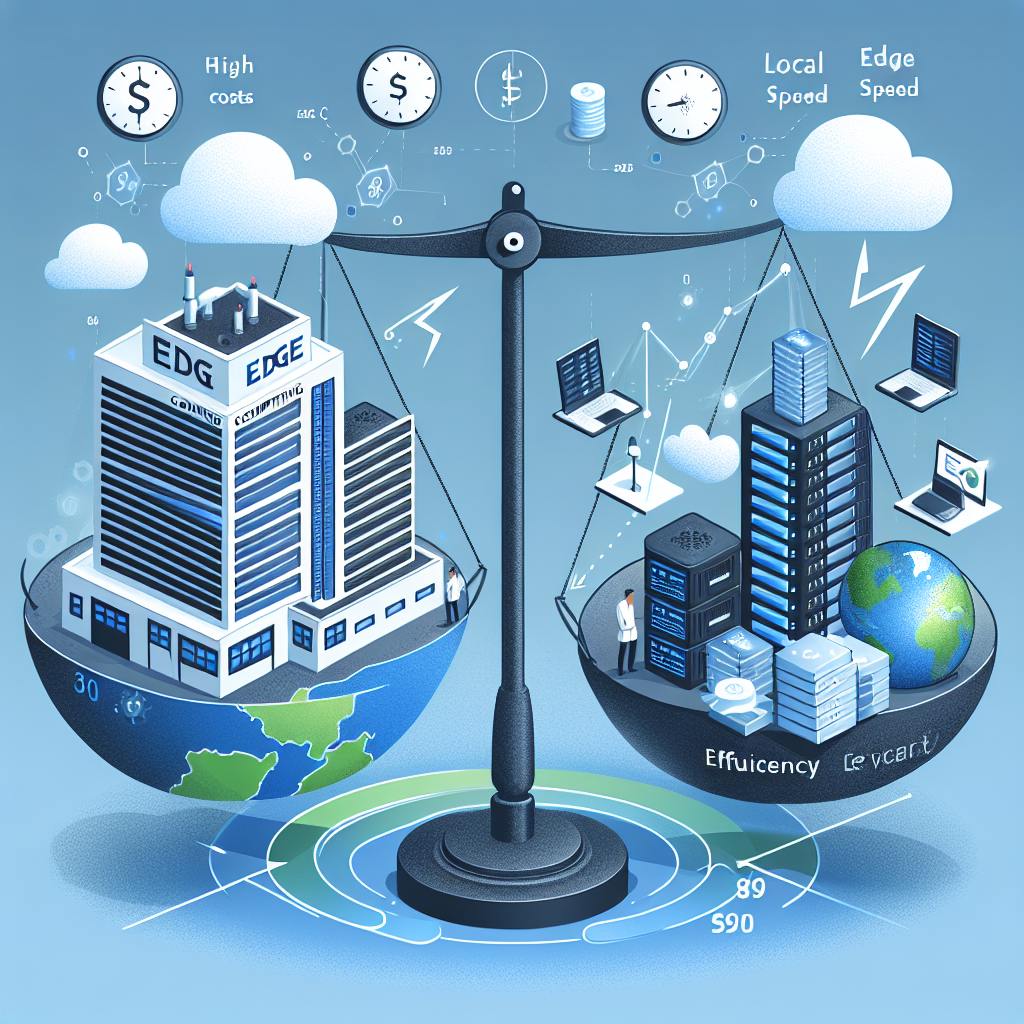-
Table of Contents
“Unlocking Efficiency: Harnessing the Power of Edge Computing”
Introduction

Edge computing is revolutionizing the way data is processed and managed by bringing computation and data storage closer to the location where it is needed. This paradigm shift from traditional centralized cloud computing to decentralized edge computing offers numerous benefits, including reduced latency, improved bandwidth efficiency, enhanced data security, and greater reliability. By processing data at the edge of the network, near the source of data generation, edge computing enables real-time analytics and decision-making, which is crucial for applications such as autonomous vehicles, smart cities, and industrial automation. This introduction explores the multifaceted advantages of edge computing and its transformative impact on various industries.
Enhancing Real-Time Data Processing with Edge Computing
Edge computing is revolutionizing the way we handle data, offering a myriad of benefits that enhance real-time data processing. As the digital landscape continues to evolve, the demand for faster, more efficient data processing has never been greater. Traditional cloud computing, while powerful, often falls short in scenarios requiring immediate data analysis and response. This is where edge computing steps in, bringing computation and data storage closer to the location where it is needed, thereby reducing latency and improving performance.
One of the primary advantages of edge computing is its ability to process data locally, at the “edge” of the network. This proximity to the data source means that information can be analyzed and acted upon almost instantaneously. For instance, in autonomous vehicles, edge computing enables real-time decision-making by processing data from sensors and cameras on the spot, rather than sending it to a distant cloud server. This immediate processing is crucial for safety and efficiency, as even a slight delay could result in catastrophic consequences.
Moreover, edge computing significantly reduces the amount of data that needs to be transmitted to central servers. By filtering and processing data locally, only the most relevant information is sent to the cloud for further analysis or storage. This not only alleviates bandwidth constraints but also enhances data privacy and security. Sensitive information can be processed and stored locally, minimizing the risk of exposure during transmission. In industries such as healthcare, where patient data confidentiality is paramount, edge computing offers a robust solution to safeguard personal information.
In addition to improving speed and security, edge computing also enhances the reliability of data processing systems. By decentralizing data processing, edge computing reduces the dependency on a single point of failure. In the event of a network outage or server failure, local devices can continue to operate independently, ensuring uninterrupted service. This resilience is particularly beneficial in critical applications such as industrial automation and smart grids, where continuous operation is essential.
Furthermore, edge computing supports the growing Internet of Things (IoT) ecosystem by enabling efficient data management and analysis. IoT devices generate vast amounts of data, and processing this data at the edge allows for quicker insights and actions. For example, in smart homes, edge computing can manage and control various devices, such as thermostats, security cameras, and lighting systems, in real-time. This not only enhances user experience but also optimizes energy consumption and reduces operational costs.
The scalability of edge computing is another noteworthy benefit. As the number of connected devices continues to surge, the ability to scale data processing capabilities becomes increasingly important. Edge computing allows for incremental scaling by adding more local processing units as needed, rather than overhauling the entire infrastructure. This flexibility makes it an attractive option for businesses looking to expand their operations without incurring significant costs.
In conclusion, edge computing offers a host of benefits that enhance real-time data processing, from reducing latency and improving security to increasing reliability and supporting IoT ecosystems. As technology continues to advance, the adoption of edge computing is likely to accelerate, driving innovation and efficiency across various industries. By bringing computation closer to the data source, edge computing not only meets the demands of today’s fast-paced digital world but also paves the way for a more connected and responsive future.
Improving Security and Privacy through Edge Computing
Edge computing is rapidly transforming the landscape of data processing and storage, offering a myriad of benefits that extend beyond mere efficiency and speed. One of the most compelling advantages of this technology is its potential to significantly enhance security and privacy. As data breaches and cyber threats become increasingly sophisticated, the need for robust security measures has never been more critical. Edge computing addresses these concerns by decentralizing data processing, thereby reducing the vulnerabilities associated with centralized systems.
To begin with, edge computing minimizes the amount of data that needs to be transmitted to central servers. By processing data locally, at or near the source, it reduces the risk of interception during transmission. This is particularly beneficial for industries that handle sensitive information, such as healthcare and finance. For instance, medical devices equipped with edge computing capabilities can analyze patient data on-site, ensuring that personal health information remains secure and private. Similarly, financial institutions can leverage edge computing to process transactions locally, thereby mitigating the risk of data breaches.
Moreover, edge computing enhances security by enabling real-time threat detection and response. Traditional centralized systems often suffer from latency issues, which can delay the identification and mitigation of security threats. In contrast, edge computing allows for immediate analysis and action, significantly reducing the window of opportunity for cyber attackers. This real-time capability is crucial for applications that require instantaneous decision-making, such as autonomous vehicles and industrial automation systems. By detecting and neutralizing threats at the edge, these systems can maintain operational integrity and protect sensitive data.
In addition to improving security, edge computing also bolsters privacy by giving users greater control over their data. In a centralized model, data is often stored and processed in large data centers, which can be located in different jurisdictions with varying privacy regulations. This can lead to concerns about data sovereignty and compliance with local laws. Edge computing alleviates these issues by keeping data closer to its source, allowing organizations to adhere to local privacy regulations more easily. For example, a smart home device that processes data locally can ensure that personal information does not leave the premises, thereby safeguarding user privacy.
Furthermore, edge computing supports the implementation of advanced encryption techniques. By processing data locally, it allows for the use of sophisticated encryption methods that may be too resource-intensive for centralized systems. This added layer of security makes it more difficult for unauthorized parties to access sensitive information. Additionally, edge devices can be equipped with hardware-based security features, such as secure boot and trusted execution environments, which provide further protection against cyber threats.
While the benefits of edge computing are clear, it is important to acknowledge the challenges that come with its adoption. Ensuring the security of edge devices themselves is paramount, as they can become targets for cyber attacks. Regular updates and patches are essential to maintain the integrity of these devices. Moreover, organizations must invest in robust security protocols and employee training to effectively manage and protect their edge computing infrastructure.
In conclusion, edge computing offers a promising solution to the growing concerns of security and privacy in the digital age. By decentralizing data processing and enabling real-time threat detection, it significantly reduces the vulnerabilities associated with traditional centralized systems. Additionally, it empowers users with greater control over their data, ensuring compliance with local privacy regulations. As the technology continues to evolve, it is poised to play a crucial role in safeguarding sensitive information and maintaining the trust of users across various industries.
Reducing Latency and Bandwidth Costs with Edge Computing
Edge computing is revolutionizing the way data is processed and managed, offering significant advantages in reducing latency and bandwidth costs. As the digital landscape continues to evolve, the demand for faster, more efficient data processing has never been greater. Traditional cloud computing models, while powerful, often struggle with the sheer volume of data generated by modern applications and devices. This is where edge computing steps in, providing a more localized approach to data processing that can dramatically enhance performance and cost-efficiency.
One of the primary benefits of edge computing is its ability to reduce latency. Latency, the delay before a transfer of data begins following an instruction, can be a critical factor in applications where real-time processing is essential. For instance, in autonomous vehicles, industrial automation, and smart cities, even a slight delay can lead to significant issues. By processing data closer to the source, edge computing minimizes the distance that data must travel, thereby reducing latency and enabling faster response times. This localized processing ensures that critical decisions can be made almost instantaneously, enhancing the overall efficiency and safety of these applications.
In addition to reducing latency, edge computing also offers substantial savings in bandwidth costs. Traditional cloud computing requires data to be sent to centralized data centers for processing, which can be both time-consuming and expensive, especially with the increasing volume of data generated by IoT devices. Edge computing alleviates this burden by processing data at or near the source, significantly reducing the amount of data that needs to be transmitted over long distances. This not only decreases the load on network infrastructure but also lowers the associated costs of data transmission. Consequently, businesses can achieve more cost-effective operations while maintaining high levels of performance.
Moreover, edge computing enhances data security and privacy. By keeping sensitive data closer to its source, the risk of data breaches and unauthorized access is minimized. This localized approach ensures that data is processed within a more controlled environment, reducing the exposure to potential cyber threats. For industries such as healthcare and finance, where data privacy is paramount, edge computing offers a robust solution to safeguard sensitive information while still leveraging the benefits of advanced data processing.
Furthermore, edge computing supports the scalability and flexibility required by modern applications. As the number of connected devices continues to grow, the ability to scale efficiently becomes increasingly important. Edge computing allows for the deployment of additional processing power at the edge of the network, enabling businesses to scale their operations without the need for significant investments in centralized infrastructure. This flexibility ensures that businesses can adapt to changing demands and continue to deliver high-quality services to their customers.
In conclusion, edge computing presents a compelling solution for reducing latency and bandwidth costs, while also enhancing data security and scalability. By processing data closer to the source, edge computing addresses the limitations of traditional cloud models and meets the demands of modern applications. As technology continues to advance, the adoption of edge computing is likely to become increasingly prevalent, offering businesses a powerful tool to optimize their operations and deliver superior performance. With its myriad benefits, edge computing is poised to play a pivotal role in the future of data processing and management.
Conclusion
Edge computing offers significant benefits, including reduced latency, improved data security, and enhanced bandwidth efficiency. By processing data closer to the source, it enables real-time analytics and decision-making, which is crucial for applications like autonomous vehicles, smart cities, and IoT devices. Additionally, edge computing reduces the load on centralized data centers, leading to cost savings and better resource management. Overall, edge computing is a transformative technology that addresses the limitations of traditional cloud computing, paving the way for more responsive and efficient digital ecosystems.





